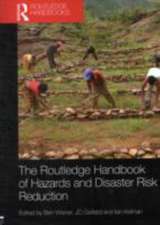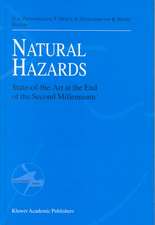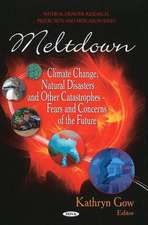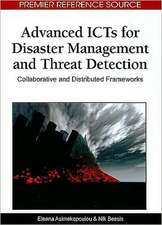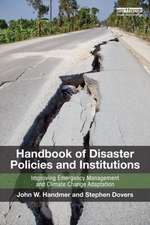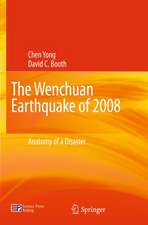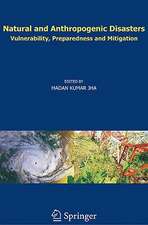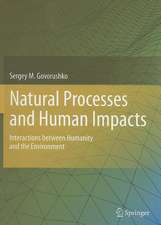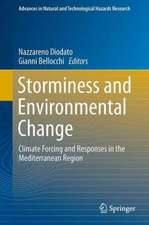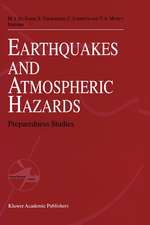Natural Disasters and Risk Management in Canada: An Introduction: Advances in Natural and Technological Hazards Research, cartea 49
Autor Nirupama Agrawalen Limba Engleză Hardback – 10 apr 2018
These chapters provide valuable and comprehensive information on a variety of hazards, including both scientific and social aspects of disasters. The work introduces the concept of large, medium and small scale hazards, and includes many useful case studies as well as working examples of theoretical concepts.
As readers will acknowledge, today the distinction between natural and technological hazards is becoming blurred and a new concept of NATECH hazards is evolving. For permanent hazards (such as tides, wind waves, coastal erosion and climate change) routine predictions are made, whereas for evanescent hazards (including droughts, sea level rise, and coastal subsidence), monitoring of various parameters is the norm. Only for episodic hazards (for example hurricanes, winter storms, tsunamis, and river floods), early warning systems are used, with varying degrees of success.
The book explores how, for certain episodic hazards liketornadoes, landslides, forest fires, snow avalanches, and volcanic eruptions, the early warning systems are still in various stages of development. Readers will gain knowledge of theoretical and practical concepts of risk evaluation which assist in better understanding of disaster dynamics, and readers will become better equipped in quantification of disaster risk and vulnerability. The author explains how risk reduction initiatives, taking into account stakeholders’ participation and perception, can provide a roadmap to building resilient communities and cities.
This book will be useful not only to practitioners of disaster management but also to research scholars and graduate students. It is highly readable and will appeal more broadly too, to all those who are interested in the very latest thinking on, and expert analysis of, hazards and disasters.
| Toate formatele și edițiile | Preț | Express |
|---|---|---|
| Paperback (1) | 488.81 lei 38-44 zile | |
| SPRINGER NETHERLANDS – 10 ian 2019 | 488.81 lei 38-44 zile | |
| Hardback (1) | 648.48 lei 38-44 zile | |
| SPRINGER NETHERLANDS – 10 apr 2018 | 648.48 lei 38-44 zile |
Din seria Advances in Natural and Technological Hazards Research
- 18%
 Preț: 977.97 lei
Preț: 977.97 lei - 18%
 Preț: 921.15 lei
Preț: 921.15 lei - 18%
 Preț: 1406.35 lei
Preț: 1406.35 lei - 18%
 Preț: 788.72 lei
Preț: 788.72 lei - 15%
 Preț: 643.84 lei
Preț: 643.84 lei - 18%
 Preț: 955.56 lei
Preț: 955.56 lei - 18%
 Preț: 954.31 lei
Preț: 954.31 lei - 18%
 Preț: 958.56 lei
Preț: 958.56 lei - 18%
 Preț: 937.56 lei
Preț: 937.56 lei - 18%
 Preț: 952.72 lei
Preț: 952.72 lei -
 Preț: 382.18 lei
Preț: 382.18 lei - 15%
 Preț: 647.92 lei
Preț: 647.92 lei - 18%
 Preț: 948.47 lei
Preț: 948.47 lei - 15%
 Preț: 640.06 lei
Preț: 640.06 lei -
 Preț: 407.01 lei
Preț: 407.01 lei - 15%
![Submarine Mass Movements and Their Consequences [With CDROM]](https://i4.books-express.ro/bs/9781402012440/submarine-mass-movements-and-their-consequences-with-cdrom.jpg) Preț: 604.37 lei
Preț: 604.37 lei - 15%
 Preț: 643.48 lei
Preț: 643.48 lei - 15%
 Preț: 648.05 lei
Preț: 648.05 lei - 18%
 Preț: 1236.99 lei
Preț: 1236.99 lei - 18%
 Preț: 947.35 lei
Preț: 947.35 lei - 18%
 Preț: 947.35 lei
Preț: 947.35 lei - 18%
 Preț: 966.15 lei
Preț: 966.15 lei - 15%
 Preț: 642.51 lei
Preț: 642.51 lei - 18%
 Preț: 951.29 lei
Preț: 951.29 lei - 18%
 Preț: 1255.16 lei
Preț: 1255.16 lei - 15%
 Preț: 642.51 lei
Preț: 642.51 lei - 15%
 Preț: 646.43 lei
Preț: 646.43 lei - 15%
 Preț: 635.96 lei
Preț: 635.96 lei - 18%
 Preț: 1244.08 lei
Preț: 1244.08 lei
Preț: 648.48 lei
Preț vechi: 842.18 lei
-23% Nou
Puncte Express: 973
Preț estimativ în valută:
124.09€ • 129.88$ • 103.28£
124.09€ • 129.88$ • 103.28£
Carte tipărită la comandă
Livrare economică 26 martie-01 aprilie
Preluare comenzi: 021 569.72.76
Specificații
ISBN-13: 9789402412819
ISBN-10: 9402412816
Pagini: 494
Ilustrații: XIX, 366 p. 212 illus., 140 illus. in color.
Dimensiuni: 155 x 235 x 25 mm
Greutate: 0.8 kg
Ediția:1st ed. 2018
Editura: SPRINGER NETHERLANDS
Colecția Springer
Seria Advances in Natural and Technological Hazards Research
Locul publicării:Dordrecht, Netherlands
ISBN-10: 9402412816
Pagini: 494
Ilustrații: XIX, 366 p. 212 illus., 140 illus. in color.
Dimensiuni: 155 x 235 x 25 mm
Greutate: 0.8 kg
Ediția:1st ed. 2018
Editura: SPRINGER NETHERLANDS
Colecția Springer
Seria Advances in Natural and Technological Hazards Research
Locul publicării:Dordrecht, Netherlands
Cuprins
Introduction to NATECH hazards.- Permanent Hazards.- Evanescent Hazards.- Episodic Hazards – large scale.- Episodic Hazards – small scale.- NATECH Hazards.- Mitigation through early warning – Developed Systems.- Mitigation through early warning – Developing Systems.- Disaster risk management.- Disaster Risk Models.- Risk and vulnerability assessment.- Resilient communities to reduce disaster risk.
Notă biografică
Dr. Nirupama Agrawal is an Associate Professor of Disaster & Emergency Management Program at York University, Canada. She has a PhD in Water Resources Engineering from Kyoto University, Japan. She specializes in disaster risk management, natural hazards multi-criteria decision support systems, and application of GIS and remote sensing techniques to disaster management. Prior to this book, she has contributed to a co-edited book, ‘Indian Ocean Tsunami’ by Taylor & Francis; a co-authored book, ‘Tsunami Travel Time Atlas for the Atlantic Ocean’ by York University; and a Special Issue on Sociological Aspects of Natural Hazards by Springer. She contributed to numerous book chapters and refereed publications in various journals and refereed proceedings. In addition to supervising and advising graduate students, Dr. Agrawal has been an active community member working with organizations such as the Council of Agencies Serving South Asians and the South Asian Women Centre. She is astaunch believer in people’s participation in resilience and capacity building. She has worked with UK based Academic Network for Disaster Resilience to Optimise Educational Development (ANDROID) and International Institute for Infrastructure Renewal and Reconstruction (IIIRR), Canada.
Textul de pe ultima copertă
These chapters provide valuable and comprehensive information on a variety of hazards, including both scientific and social aspects of disasters. The work introduces the concept of large, medium and small scale hazards, and includes many useful case studies as well as working examples of theoretical concepts.
As readers will acknowledge, today the distinction between natural and technological hazards is becoming blurred and a new concept of NATECH hazards is evolving. For permanent hazards (such as tides, wind waves, coastal erosion and climate change) routine predictions are made, whereas for evanescent hazards (including droughts, sea level rise, and coastal subsidence), monitoring of various parameters is the norm. Only for episodic hazards (for example hurricanes, winter storms, tsunamis, and river floods), early warning systems are used, with varying degrees of success.
The book explores how, for certain episodic hazards liketornadoes, landslides, forest fires, snow avalanches, and volcanic eruptions, the early warning systems are still in various stages of development. Readers will gain knowledge of theoretical and practical concepts of risk evaluation which assist in better understanding of disaster dynamics, and readers will become better equipped in quantification of disaster risk and vulnerability. The author explains how risk reduction initiatives, taking into account stakeholders’ participation and perception, can provide a roadmap to building resilient communities and cities.
This book will be useful not only to practitioners of disaster management but also to research scholars and graduate students. It is highly readable and will appeal more broadly too, to all those who are interested in the very latest thinking on, and expert analysis of, hazards and disasters.
Caracteristici
Introduces a comprehensive approach for disaster risk evaluation Includes numerous examples and case studies of disasters and risk evaluation Enhances understanding through superb illustrations, graphs and charts Identifies early warning systems for various types of hazards Provides working examples of theoretical concepts

